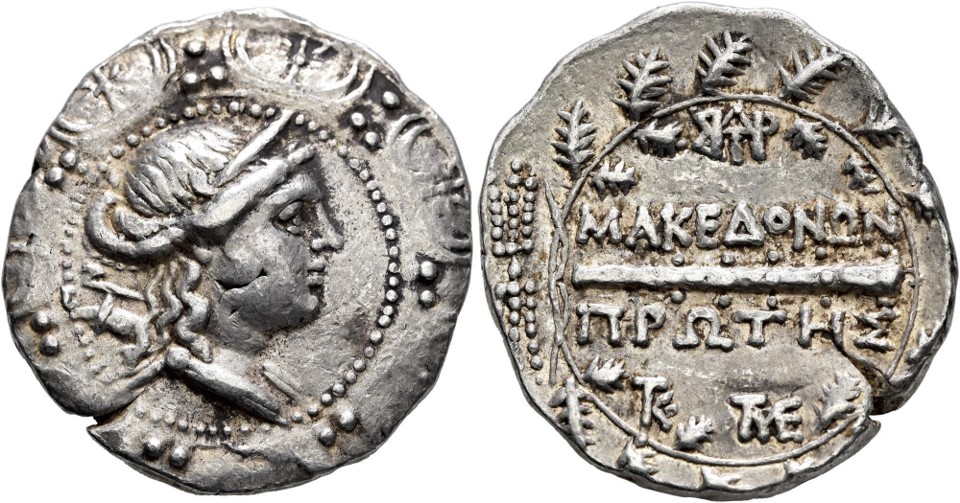167 BCE - 149 BCE | MAKEΔΟΝΩΝ ΠΡΟΤΗΣ
Overstriking coin
Amphipolis_First_Meris_Leu_Numismatik,_EA_26,_8_July_2023,_740.jpg
[1]
|
|
Sale(s)Sale(s) ᵖ:
|
Leu Numismatik, EA 26, 8 July 2023, 740.
|
| Private collection(s)Private collection(s) ᵖ:
|
"From a European collection, formed before 2005"
|
|
Description
| ObverseInscription or printing placed on the obverse.:
|
Diademed head of Artemis right on Macedonian shield
|
ReverseInscription or printing placed on the reverse.:
|
MAKEΔΟΝΩΝ ΠΡΟΤΗΣ (Greek) Wreath containing club. By wreath ties, fulmen. Monograms
|
Mint and issuing power
Chronology
| FromIdentifies the initial date in a range assigned in a numismatic context. 167 BCE toIdentifies the final date in a range assigned in a numismatic context.. 149 BCE
|
Hellenistic 323-30 BC  periodTime period of the numismatic object. periodTime period of the numismatic object.
|
Physical description
MetalThe physical material (usually metal) from which an object is made.: Silver 
|
WeightWeight of the numismatic object (in grams). in grams: 16.7616.76 g <br />16,760 mg <br />
|
DenominationTerm indicating the value of a numismatic object. Examples: tetradrachm, chalkous, denarius.: tetradrachm 
|
AxisDescribes the directional relationship between the obverse and reverse of a numismatic object.: 1212 mm <br />1.2 cm <br />
|
| DiameterDescribes diameter of an object (in mm).: 3131 mm <br />3.1 cm <br />
|
StandardStandard.: Attic
|
References
Description
| ObverseInscription or printing placed on the obverse.:
|
|
ReverseInscription or printing placed on the reverse.:
|
|
Mint and issuing power
| MintIdentifies the place of manufacture or issue of a numismatic object. ᵖ:
|
|
Ancient regionAncient region. ᵖ
|
|
Modern countryModern country:
|
AuthorityIdentifies the authority in whose name (explicitly or implicitly) a numismatic object was issued. ᵖ:
|
|
Chronology
| FromIdentifies the initial date in a range assigned in a numismatic context. toIdentifies the final date in a range assigned in a numismatic context..
|
periodTime period of the numismatic object.
|
Physical description
References
References
- ^ Gaebler, Hugo (1906), Die antiken Münzen Nord-Griechenlands, unter Leitung von F. Imhoof-Blumer. Band III, Makedonia und Paionia. 1. Abt., Verlag W. de Gruyter, Berlin, 196 p.
- ^ Hoover, Oliver D. (2016), Handbook of coins of Macedon and its neighbors. 3. Part I: Macedon, Illyria, and Epeiros, sixth to first centuries BC, Lancaster, 437 p.
- ^ Callataÿ, François de (2021), “On pattern and purpose of overstrikes of late Hellenistic tetradrachms in Thrace Macedonia”, in Ulrike Peter and Bernhard Weisser (eds.), Thrace. Local coinage and regional identity, Berlin Studies of the Ancient World 77, Berlin, Topoi, p. 263-289.

